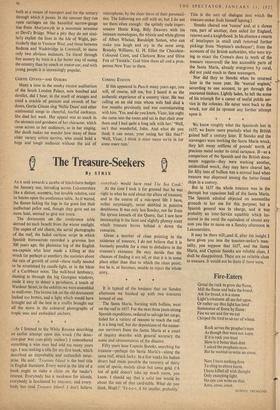The Treasure-Seekers
By STR 1 X As it sank towards a zarcba of blackthorn hedges the January sun, intruding across Leicestershire like a distant, eccentric, but lovable relative, cast its beams upon the conference table. As it waned, the flames licking the logs in the grate lost their ineffectual pallor and, though they gave out no more heat, seemed to give out more.
The documents on the conference table derived no such benefit from the winter sunlight. The copies of old charts, the aerial photographs of the reef, the faded curlicue script in which Spanish bureaucrats recorded a grievous loss 300 years ago, the photostat log of the English sea-captain who later made a killing at this wreck (or perhaps at another), the statistics about the rate of growth of coral—these really needed to be scrutinised by candle-light, or in the blaze of a Caribbean noon. The well-bred lambency, slanting in through the big Georgian windows, made it easy to detect a garishness, a touch of Wardour Street, in the exhibits we were assembled to mull over. The brown ink on the old documents looked too brown, and a light which would have brought out all the best in a muffin brought out all the worst in the coloured photographs of tropic seas and embedded anchors.
As I listened to the White Russian describing an earlier attempt upon this wreck ('the detec- tion-gear was cont-plitly useless') I remembered something a wise man had told me many years ago. I was seeking a title for my first book, which described an improbable and outlandish enter- prise. He said : 'Treasure Islam! is the best title in English literature. Every word in the title of a book ought to stake a claim on the reader's interest. Everybody has a weakness for islands, everybody is fascinated by treasure; and every- body has read Treasure Island. I don't believe everybody would have read The Sea Cook.'
At the time I took it for granted that he was right in what he said about the allure of treasure; and in the course of a mis-spent life I have, rather surprisingly, never dabbled in putative doubloons. It was only last Sunday, not far from the spruce kennels of the Quorn, that I saw how intoxicating is the faint and slightly phoney scent which treasure leaves behind it down the centuries.
Given a number of clues pointing tv the existence of treasure, I do not believe that it is humanly possible for a man to disbelieve in the treasure's existence. He may decide that the chances of finding it are nil, or that it is in some place other than that to which the clues point; but he is, or becomes, unable to reject the whole story.
It is typical of the business that on Sunday afternoon we finished up with two treasures instead of one.
The Santa Maria, bursting with bullion, went on the reef in 1637. For the next three years strong Spanish expeditions, ordered to salvage her cargo, failed for a variety of reasons to reach the reef. It is a long reef, but the depositions of the numer- ous survivors from the Santa Maria at a court of inquiry describe with general accuracy the scene and circumstances of the disaster.
Fifty years later Captain Snooks, searching for treasure—perhaps the Santa Maria's—along the same reef, struck lucky. In a few weeks his Indian divers had made possible the recovery of thirty tons of specie, mainly silver but some gold. ('A ton of gold doesn't take up much room, you know. I should say that a solid ton would be about the size of that card-table. What do you think, Hugh?"Ye-e-c-s. A bit smaller, probably.' This is the sort of dialogue into which the treasure-seeker finds himself lapsing.) Snooks cleared one 'roome' and, at a slower rate, part of another, then sailed for England, renown and a knighthood. In his absence a swarm of interlopers in small craft removed further pickings from 'Neptune's exchequer'; from the accounts of the British authorities, who were try- ing to exact the Crown's dues (a tenth of the treasure recovered) the less accessible parts of the Santa Maria, already overgrown by coral, did not yield much to these scavengers.
Nor did they to Snooks when he returned later in the same year. He 'wanted engines,' according to one account, to get through the encrusted timbers. Lightly laden, he left the scene of his triumph for a career of useful public ser- vice in the colonies. He never went back to the wreck, nor did he sponsor any further attempt upon it.
* * *
We know roughly what the Spaniards lost in 1637; we know more precisely what the British gained half a century later. If Snooks and the scavengers were working the Santa Maria wreck, they left many millions of pounds' worth of precious metal under its coral carapace. If—as a comparison of the Spanish and the British docu- ments suggests—they were working another, unidentified wreck, they may have cleared her, for fifty tons of bullion was a normal load when treasure was dispersed among the better-found ships in a convoy.
But in 1637 the whole treasure was in the decrepit but capacious hull of the Santa Maria. The Spanish admiral objected on seamanlike grounds to her use for this purpose; but a Spanish general was in charge, and it was probably an inter-Service squabble which im- mured in the coral the equivalent of almost any sum you like to name on a Sunday afternoon in Leicestershire.
It may be there still;„and if, after the insight I have given you into the treasure-seeker's men- tality, you suppose that 1637, and the Santa Maria, and Captain Snooks are reliable clues, I shall be disappointed. There are no reliable clues to treasure. It would not be there if there were.


































 Previous page
Previous page